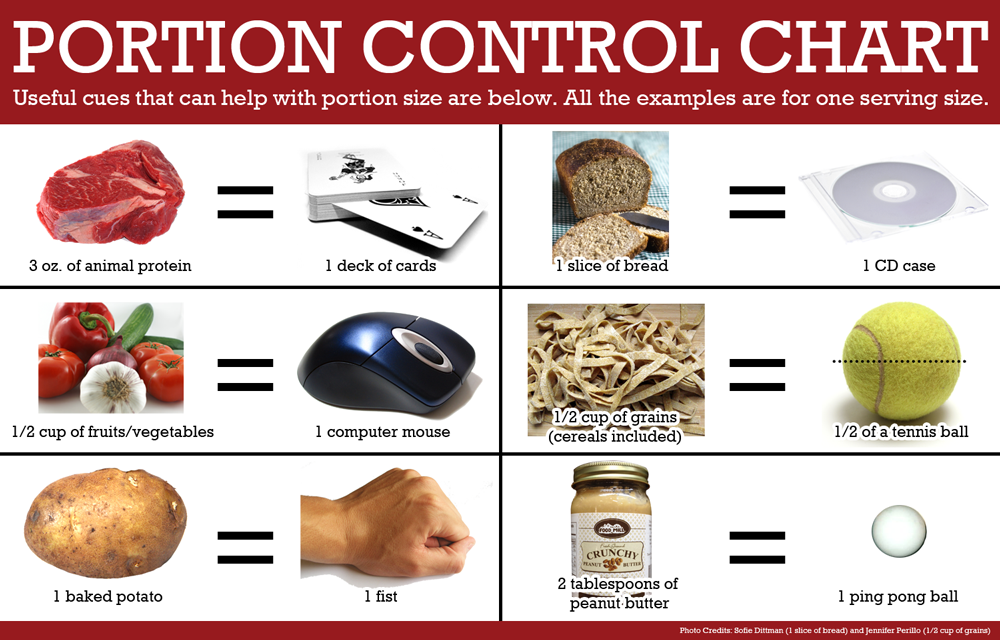New Year, New You: Part 4 | Portion Control

Geri Wohl, CNC
Better Eating Coach
Written By: Geri Wohl, CNC
www.bettereatingcoach.com
We know that food is as basic to our survival as the air we breathe. Can you have too much of a good thing? Of course! You may think that you are eating healthy foods but the scale doesn’t show any difference in your weight. Is there something else to try? Portion control. A new study demonstrates that controlling portion size may be the single most effective action to have a lasting impact on one’s weight.
Some basic math comes into play. In order to maintain weight, the calories you ingest must be equal to the calories you burn. To lose weight, more calories must go out than go in. To lose one pound, you need to burn about 3500 calories. While exercise is important in this equation, changing your diet by reducing the number of calories consumed will result in pounds lost. For example, if you reduce your intake by 500 calories/day, you can lose one pound in a week. Over a period of three months, that can add up to 12-13 pounds. When you add exercise into the equation, you will increase your metabolic rate and burn even more calories, which will fortunately be from fat instead of muscle resulting in more weight loss. The topic of exercise will be explored in a future article.
Consuming the appropriate amount of calories is essential for proper functioning of the body. While we don’t want to eat too many calories, we also want to avoid too few calories. If the body senses that it doesn’t have enough fuel with which to work, it will go into “starvation mode” and holds onto every calorie consumed making weight loss that much harder. For more guidance about this, contact me at www.bettereatingcoach.com.
Remember that portion sizes are different from the serving sizes that were explained in the last article, “Look at the Label.” Portion size is amount of a food consumed at a single eating session. Serving size is a standardized unit of measurement based on a typical 2000-calorie diet. Our portion sizes have increased significantly over the last twenty years. In addition to eating fewer calories, decreasing portion size has the added benefits of allowing people to feel better, having more energy and improving their digestion. Here are some strategies to help with reducing portion sizes. If you are eating at home, try some of the following:
- Use smaller dishes. This visual cue will relay to the brain that you are obtaining enough food.
- Start your meal with a salad or liquid-based soup. This starter will begin to fill you up so that you are not as hungry for the remainder of the meal as well as the added benefit of consuming more fiber. For more about the benefits of fiber, see my article, “It’s Good To Be Green.”
- Don’t serve dinner from the table. Otherwise, it becomes too easy to grab for seconds and tack on additional calories. Keep your serving dishes on the stovetop or counter instead.
- Wait 20 minutes before getting seconds to determine if you are actually still hungry. It takes about that time for the satiety hormones to register and let you know that you are “full”.
- Avoid eating out of a box. Place an amount into a small bowl instead and put the box away. It is too easy and tempting to keep it in front of you while limiting yourself.
- If you are hungry between meals, snack on fruit, vegetables or salads.
- Load your plate with lots of vegetables, which will fill you up without a lot of calories. If consuming animal protein, only have it take up 25% of your plate.
- Go easy on the starchy foods that are easy to overeat without a lot of nutritional value.
- Become acquainted with serving amounts. Measure out a serving of cereal and see how much is really a ½ cup. After a bit, you will know by sight how accurate you are.
If you are eating out, remember that restaurants love to serve large portions. People also tend to eat all the food that is placed in front of them. The result is too many calories! When eating out, here are some useful strategies:
- Choose an appetizer as an entrée where appropriate. It may be completely filling and more economical.
- Split an entrée with your dining companion or bring half your meal home with you. If you bring home a “doggy bag”, you’ll save yourself the effort of preparing an extra meal while cutting your calories.
- Pass on the bread basket. These are calories that can easily be shaved off the daily count.
- If eating out with others, try sharing a few dishes. You’ll be able to get a variety of foods without feeling you need to eat everything on the plate in front of you.
Other useful cues that can help with portion size are below. All the examples are for one serving size.
Consuming smaller quantities of food are essential to one’s weight loss goals. We need to overcome the many sensory cues we experience to stay the course and be more attuned to our body’s hunger signals. The result will be fewer pounds on the scale.
© Geri Wohl, CNC











